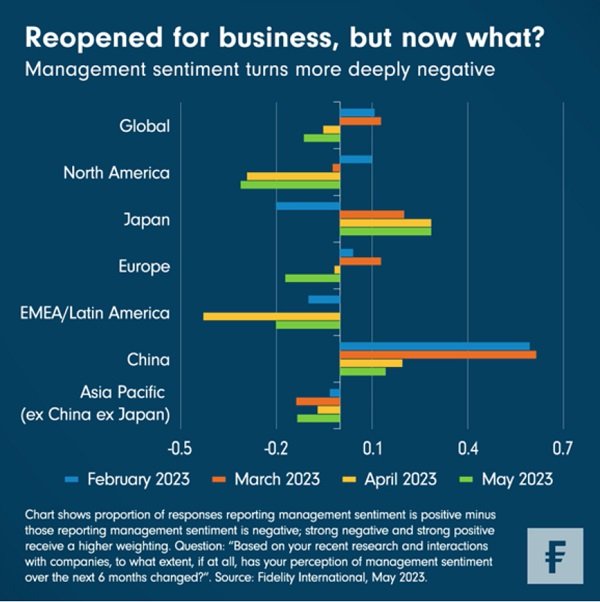Fidelity: Reopened for business, but now what?

The results of Fidelity International’s latest monthly analyst survey were dominated by a series of downside surprises in China and Europe, as aggregate global sentiment turned more deeply negative compared with the previous month.
The sudden return of Chinese society and businesses to something resembling normality last December helped offset bearishness in other markets at the start of the year and boosted the survey’s main global sentiment index, which measures how managers see the period ahead. But as this week’s Chart Room shows, that initial enthusiasm in China has waned while sentiment declined further in Europe and other regions, sending the global numbers deeper into negative territory.
On their own, the numbers for China are still positive, but sentiment gains are slowing as a more cautious tone begins to pervade. “Most companies are still optimistic (or hopeful) of a recovery”, says one China-focused analyst, “but we are hearing more qualifiers like ‘moderate’ and ‘gradual’ and more management caveating their outlook with it being dependent on the recovery continuing.” Enthusiasm is becoming more nuanced: “Overall, while there continue to be signs of a macro recovery, it’s more gradual (and more patchy) than some had hoped.”
Another analyst, who follows Chinese IT companies, also notes a more difficult macro backdrop: “The recovery is not just about China reopening, but also about macro”, she says, adding, “there’s price pressure in some sectors and competition is getting tougher.”

Globally, with the notable exceptions of Japan and EMEA/Latin America, sentiment deteriorated on a sequential basis this month. This chimes with the growing gloom about growth, and the likelihood of recessions in the West, that have weighed on markets in the past month following the recent focus on banking worries in the US and Europe.
Sectorally, only defensives like healthcare and utilities are holding up. The outlook for energy companies has worsened on the back of a relatively weak oil price this year reflecting global recession concerns (US diesel demand, for instance, is showing signs of modest softness, reflecting weak manufacturing Purchasing Managers’ Index numbers), as well as gas prices weakening off the back of a relatively warm winter, and falling refining margins. Materials too have lulled following the immediate surge after Chinese New Year. The picture for financials is more nuanced: the regional banks crisis has weighed significantly on US banks’ management sentiment, but financials in other regions are proving more resilient.
The silver lining, as suggested by the survey, is that cost inflation is slowing materially, and non-labour costs could conceivably turn deflationary as soon as June or July. The lower oil price is having an effect across businesses while the base effect of inflated prices set in annual contracts last year is reducing other commodity costs sharply. Even labour inflation has come off a bit, falling to its lowest level in two years.
All of that, of course, is consistent with a narrative of impending recession and easing inflation, both of which, as we and most market participants have been saying for months, should lead to an eventual Fed pivot. But that alone seems unlikely to save markets.
